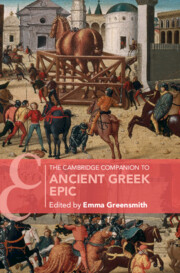Book contents
- The Cambridge Companion to Ancient Greek Epic
- The Cambridge Companion to Ancient Greek Epic
- Copyright page
- Contents
- Figures
- Contributors
- Preface
- Introduction
- Part I Epic Engagements
- Part II Epic Space
- Part III Epic Time
- Part IV Epic People
- 11 The Language of Epic Sacrifice
- 12 Epic Racecraft and the Race of Heroes
- 13 Women in Homer and Beyond
- Part V Epic Feelings
- Part VI Epic Without End
- Epilogue
- Timeline of Ancient Greek Epic
- Bibliography
- Index Locorum
- Subject Index
- Cambridge Companions To Literature
11 - The Language of Epic Sacrifice
from Part IV - Epic People
Published online by Cambridge University Press: 04 December 2024
- The Cambridge Companion to Ancient Greek Epic
- The Cambridge Companion to Ancient Greek Epic
- Copyright page
- Contents
- Figures
- Contributors
- Preface
- Introduction
- Part I Epic Engagements
- Part II Epic Space
- Part III Epic Time
- Part IV Epic People
- 11 The Language of Epic Sacrifice
- 12 Epic Racecraft and the Race of Heroes
- 13 Women in Homer and Beyond
- Part V Epic Feelings
- Part VI Epic Without End
- Epilogue
- Timeline of Ancient Greek Epic
- Bibliography
- Index Locorum
- Subject Index
- Cambridge Companions To Literature
Summary
This chapter analyses the richness and relevance of epic scenes of sacrifice. The detailed descriptions of animal sacrifice found in Homer not only stand out for their rich diction and complex narrative resonance, but they are also unique for the dominant referential role that they continued to play in Greek representations of sacrifice, most notably in later epic poetry. After a quick review of the major sacrifices in Iliad 1, Odyssey 3 and Odyssey 14, Gagné turns to the sacrifice of a cow to Athena in Book 5 of Nonnus’ Dionysiaca, the only detailed sacrificial scene in that massive poem, and the double sacrifice to Apollo in Book 1 of the Argonautica, one of the most emphatic sites of engagement with the verses of Homer in Apollonius. One puzzling verb of Homer, ὠμοθετεῖν, serves as a guiding thread throughout this study on the shifting language of ritual representation. By assessing the traditional language of Homeric sacrificial scenes, and these dramatic examples of its reception in later epic, Gagné demonstrates the enduring, canonical presence of Homeric sacrifice in the development of a tradition of poetic reference, in what he terms ‘the ritual archive’ of Greek epic.
- Type
- Chapter
- Information
- The Cambridge Companion to Ancient Greek Epic , pp. 231 - 257Publisher: Cambridge University PressPrint publication year: 2024

